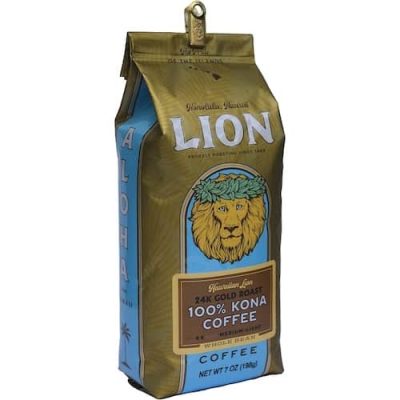Best 100% Kona Coffee Brands | From Hawaii To Your Mug
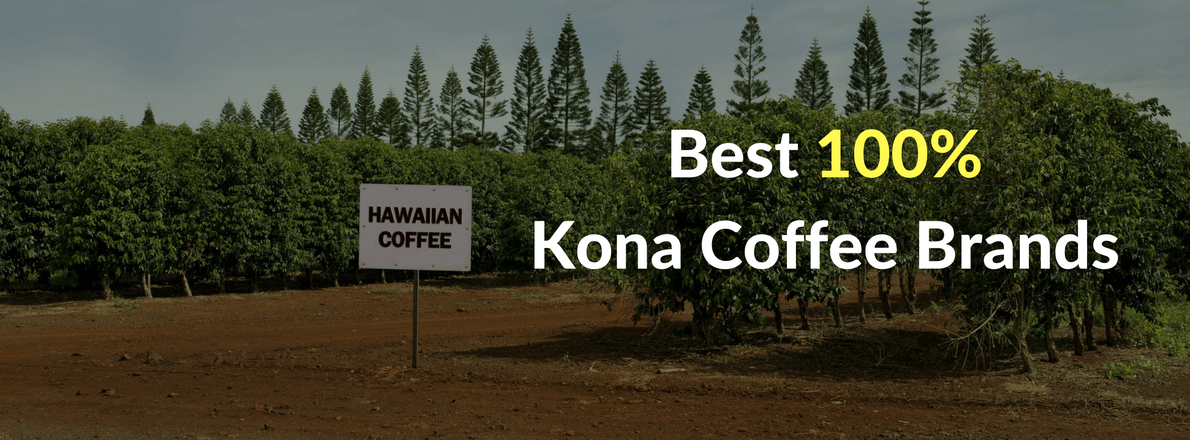
If you love coffee and haven’t tried Kona, you’re in for a luscious treat! If you’re already a fan, then you know it’s one of the finest gourmet coffees sold.
What you may not know is what constitutes the best.
Here’s a comprehensive buying guide and the perks of this premium bean.
Best Hawaiian Coffee Brands
Volcanica Hawaiian Kona Peaberry
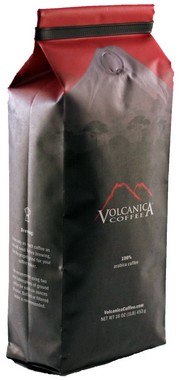
Part of what makes Volcanica’s Kona coffee so delicious is its incredible flavor profile and character.
Because Volcanica’s coffee plants are shade grown and benefit from rich volcanic soil, the resulting beans are low in acid. Growing conditions around the company’s estate are ideal for creating incredible coffee with a sweet flavor: the rain and humidity levels as well as elevation all work together to create Kona coffee that’s unequaled.
This particular variety is 100% pure, with only the highest quality beans making it into each bag. The Peaberry beans are expertly roasted to achieve a beautifully rounded flavor, guaranteeing that each cup is full bodied, rich, and satisfying.
To ensure optimal flavor this coffee is only roasted and ground once your order is placed, and there are four grind options: French press, whole bean, drip grind, and espresso grind.
Grande Domaine Kona Coffee
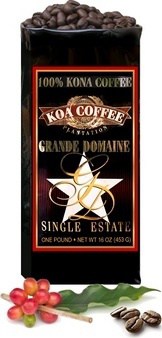
Kona coffee is one of the most highly valued varieties in the world, and one brand that excels at roasting these premium beans is Koa Coffee.
The company procures its beans from trees planted well over a century ago in 1918, which lends each cup of coffee superb flavor and quality. Grande Domaine single estate Hawaiian coffee is exceptionally smooth, and it’s a great choice if you’re looking for a richly flavored coffee without any bitter aftertaste.
It’s balanced flavor makes this a wonderful coffee to sip at any time, from morning to after dinner — if you’re looking to impress guests, you truly can’t go wrong serving it. Grande Domaine is available in three different sizes and two grind types: whole bean and auto drip grind. Since the beans are freshly roasted and ground to order, you’re guaranteed maximum flavor.
Hawaii Coffee Company Royal Kona Private Reserve
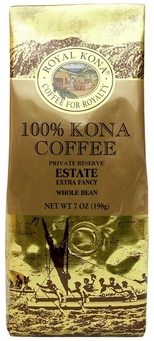
Hawaii Coffee Company has been producing wonderful varieties for decades, and one of its premium offerings is its Royal Kona Private Reserve. It’s a pure Kona blend with an aroma that’s truly magnificent.
The fragrance that comes from Royal Kona Private Reserve as its brewing truly heightens the experience of drinking it and is only surpassed by its taste.
Because the Kona coffee beans used in this variety are of the highest quality, the resulting brew is smooth and rich with a full body — the flavor profile of this Hawaiian coffee is so well rounded that it was judged as Superior by the American Academy of Taste.
Royal Kona Private Reserve is available in whole bean form or as an all purpose grind. The beans are medium roasted to order, which makes this coffee well suited for any occasion or time of day.
Lion’s Hawaiian Coffee
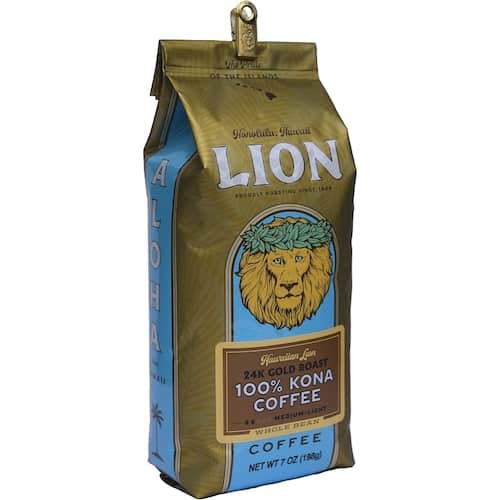
All Kona coffee isn’t made equally — even those blends that are pure can differ due to growing conditions, manner of picking, and roasting techniques.
Lion’s Hawaiian Coffee stands out as being one of the best premium Kona brands around. Not only is the Extra Fancy coffee used in the company’s blend handpicked and top quality, it’s perfectly roasted right when you order it. The beans used in Lion’s Hawaiian Coffee are sourced straight from farms on the Big Island, right on the volcanic slopes of Holualoa.
The growing conditions in the region produce coffee that’s balanced and well flavored with a character that’s uniquely Hawaiian. Light-Medium roasting the beans ensures that you’ll enjoy all of the coffee’s flavor notes, which include passion fruit and toasted coconut. The aroma of this coffee is divine, and the taste is one that you’ll only find from exceptional quality Kona beans.
What is Kona Coffee?
Kona coffee is the market name for coffee grown in the Kona District of Hawaii. A variety of Arabica coffee. And it’s considered a supremely high-quality joe.
Several attributes make this brew prized worldwide.
What’s special about Kona?
Kona has a distinct taste profile, a mix of six characteristics – aroma, flavor, sweetness, acidity, body, and aftertaste. Here are the qualities that make Kona unparalleled:
What also makes Kona unique is its physical effect. Kona doesn’t produce the jitters of regular joe. After drinking a cup of Kona, you’ll feel rejuvenated and calm.
This flavor profile is a generalization. The type of bean produced varies by plantation. Beans from one farm may have a berry aroma while those from another have a vanilla scent. Also diverse are the dominant flavor notes.
Where is Kona grown?
The Kona coffee belt is located on the slopes of Hualalai and Mauna Loa, two dormant volcanoes located on the big island of Hawaii.
This region provides the ideal growing climate – rich volcanic soil, sunny mornings, overcast afternoons, mild nights, and humid air. Afternoons are generally misty or rainy. These specific conditions produce Kona’s distinctive flavor.
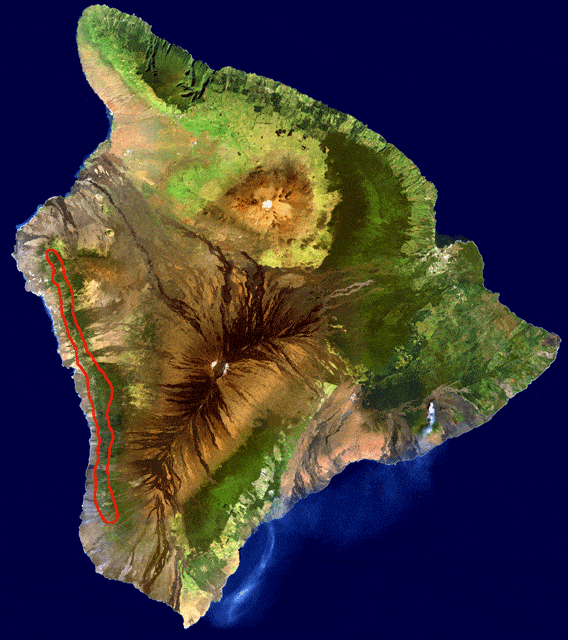
How is Kona cultivated?
The growing season is a full 12 months:
Can you guess how long it takes for a Kona tree to bear fruit? Three years are required to reach maturity! Each tree produces roughly 25 pounds of “cherries.” It takes eight pounds of cherries to make one pound of coffee. Doing the math, one tree yields about three pounds of coffee. Currently, roughly 700 Hawaiian farms produce the entire world’s supply!
The fruit begins as a green berry that turns deep red when ripe. Each cherry contains one or two seeds, which are the coffee beans. The cherries are hand-picked at peak maturity.
Why are the berries hand-picked?
The berries ripen at varying times, requiring a discerning eye. The lava landscape also doesn’t lend itself to mechanical cultivation, being rocky and hilly. Therefore, planting, cultivating, and harvesting are all done by hand. Kona cultivation is the most labor-intensive agricultural industry in the world!
How are the berries harvested?
Workers select berries on the basis of size, color, and firmness. Then they’re sent through a machine that removes the flesh. What remains are the coffee beans, which are then cleaned and dried.
Once the berries are picked, the coffee is processed within 24 hours. How’s that for freshness! This expediency is necessary to protect the fruit from spoilage.
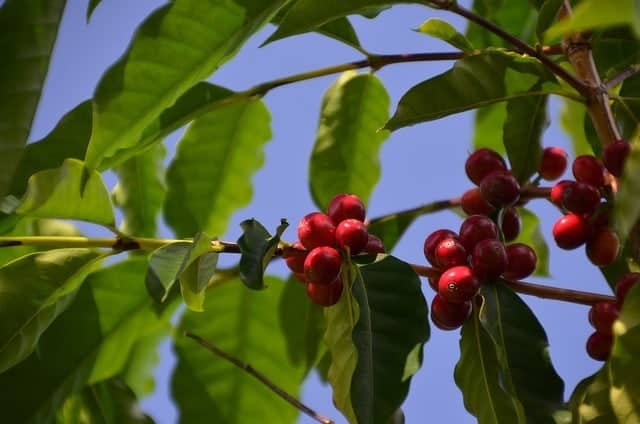
What is the history of Kona coffee?
This will surprise you! Kona isn’t native to Hawaii. Coffee beans and plant cuttings were first brought to Oahu from Brazil in 1828. The Hawaiian climate proved ideal, and Kona crops flourished. In the late 1800s, the Brazilian plants were replaced by stock from Guatemala, from which modern crops are descended.
During the 1960s, Kona production slowed, reflecting changes in labor costs, pricing, and market demand. In the late 1980s, interest resumed when gourmet coffee gained popularity. Coffee shops increasingly sold the novel joe, and the beans appeared on store shelves.
Why does Kona cost more than regular coffee?
Prices reflect the labor-intensive production expenses, high demand, and limited supply. To make it more affordable, many retailers sell Kona blends.
What are Kona blends?
Kona blends are a mix of less expensive beans. They may be sourced from Africa, Brazil, Central America, or Indonesia. Hawaiian Kona blends must include at least 10 percent Kona. Outside Hawaii, a blend may have only 1 percent or less of Kona. In fact, technically, a blend can have merely one Kona bean!
State law mandates that blends must show the percentage of Kona on their labels. For pure products, labels must prominently display the words “100% Kona Coffee.”
Does a government authority oversee production?
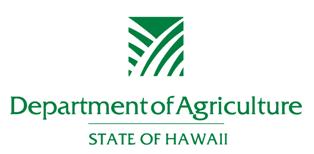
The Hawaii Department of Agriculture requires Kona coffees to pass inspection before they can carry a “Kona” label. Beans are first classified and then assigned a grade.
Inspectors also certify the coffee by “cupping” it, sampling the brewed coffee to assess its aroma and flavor. State certification is required for Kona growers and processors to sell beans outside the Kona District.
How are the beans classified?
There are two types of beans:
Usually, a cherry contains two beans which are flat on each side. Sometimes only one of the seeds gets fertilized, and a single seed develops, with nothing adjacent to flatten it. The oval seed is known as a “peaberry.”
Only 5 percent of Kona beans grow as peaberries. In other words, out of every 100 bags of Kona coffee, just 5 bags are Peaberry! Although the beans are small, they produce a more robust flavor than regular Kona beans. Peaberry is the “champagne” of coffee beans.
How are the beans graded?
Kona beans are graded by:
Generally, larger beans have more flavor, and beans with the least defects are preferred. If beans are hollow, chipped, or deformed, they don’t roast uniformly and have less flavor.
This grading system applies only to beans from the Kona District. Beans from other Hawaiian regions are merely separated by size, resulting in varying taste profiles.
What are the grades?
There are five primary grades of beans:
| ALLOWANCE FOR DEFECTS* | MINIMUM SIZE (tolerance for undersize – 10% by wt.) | |
|---|---|---|
| Extra Fancy | 8
FULL IMPERFECTIONS PER 300 GRAMS | Type I – Size 19
Type II – Size 13 |
| Fancy | 12
FULL IMPERFECTIONS PER 300 GRAMS | Type I – Size 18
Type II – Size 12 |
| Number 1 | 20
FULL IMPERFECTIONS PER 300 GRAMS | Type I – Size 16
Type II – Size 10 |
| Select | 5%
DEFECTIVE BEANS INCL. NOT>2% FULL SOUR STINKER, BLACK OR MOLDY | Optional (May be specified) |
| Prime | 20%**
DEFECTIVE BEANS INCL. NOT>5% FULL SOUR STINKER, BLACK OR MOLDY | Optional (May be specified) |
*Defects are scored as either full imperfections or less than full imperfections. Less than full imperfections are scored as one‐fith of a full imperfection.
Kona is King!
Kona is favored for its full-bodied flavor and low acidity. Only coffee from the Kona District is state-inspected and certified for origin.
This is your assurance of the best Kona coffee available. One sip will convince you that Kona is the King of coffees!
